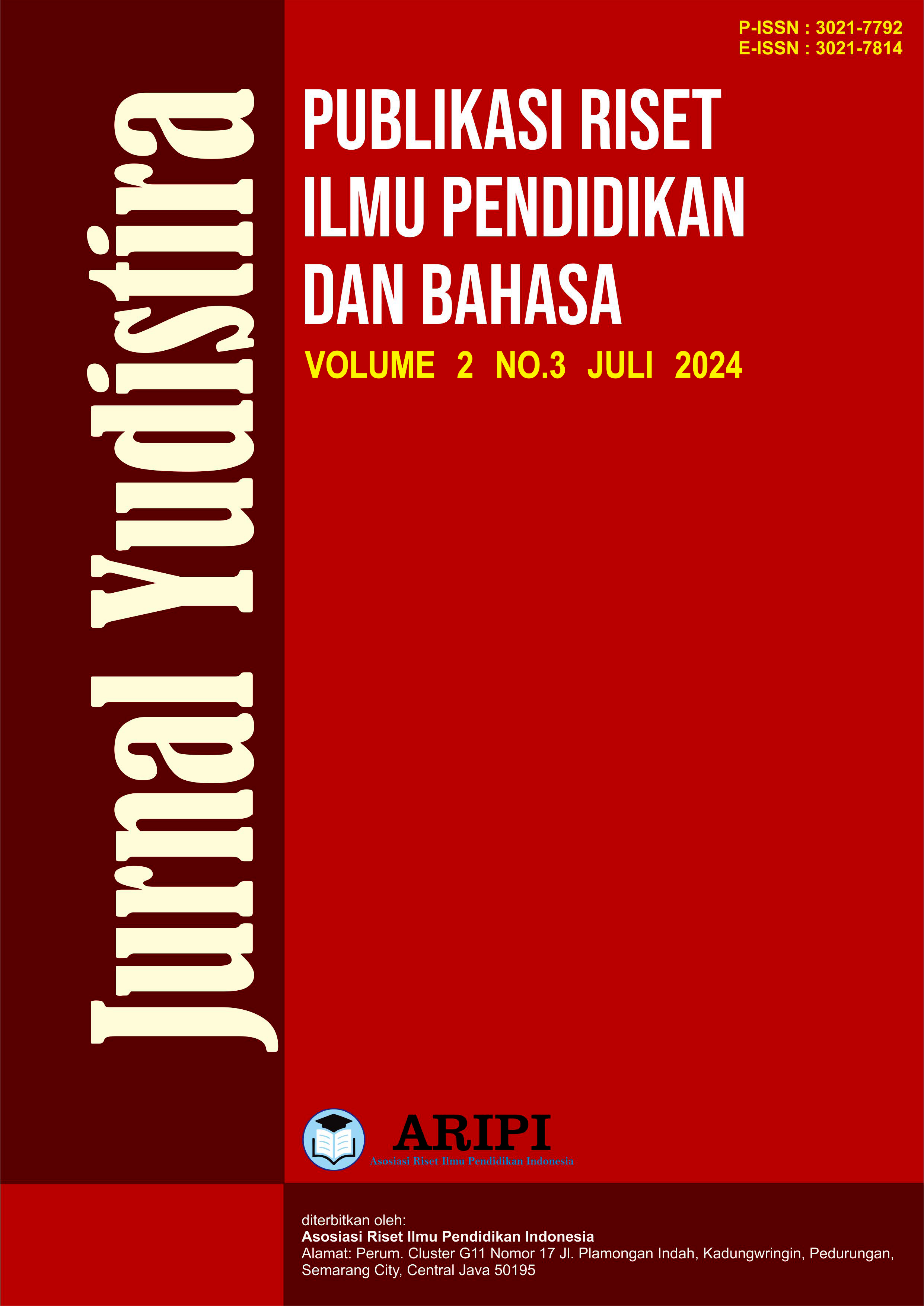An Error Analysis Of Article System: A Case Of ESP Students
DOI:
https://doi.org/10.61132/yudistira.v2i4.1163Keywords:
Error Analysis, English Article System, ESP StudentsAbstract
Analyzing errors is very important for ESP students because they can relate to their work, it also provides ESP students with corrections Errors in learning behavior. This research aimed to investigate the errors, the most prominent type, and the causes of errors in using English articles in academic writing. The Researcher examined the academic writing by the ESP students. The researchers use an analytical parameter developed based on Biber et al. (1999) to analyze article errors. The causes of errors were obtained through a questionnaire developed based on the categories proposed by Brown (2007). After analyzing the data, the Researcher found 30 errors in Addition, Omission, and substitution categories. The most prominent type of Error is omission error, with a frequency of 293 occurrences or 76%. The main type of omission error is an omission of the definite article "the" before nouns or noun phrases. In contrast, the major cause of errors is mother tongue influence, with an average mean of 4.17 in the questionnaire responses. This study's findings indicate the need for teaching strategies and materials to prevent common article usage errors.
Downloads
References
Ahmad, K., & Khan, A. Q. (2021). The underlying reasons for the difficulties in use of the english articles for ESP learners: An analysis based on the learners’ experiences. Eurasian Journal of Applied Linguistics, 7(1), 420–434. https://doi.org/10.32601/ejal.911479
Albrecht, S. (2021). Current research on the linguistic features of Chinese English. World Englishes. https://doi.org/10.1111/weng.12572
Al-husban, N. (2018). Error Analysis of Jordanian First - Year University Students’ English Language Writing at Arab Open University – Case Study. International Journal of Pedagogical Innovations, 6(1), 23–30. https://doi.org/10.12785/ijpi/060103
Apuke, O. D. (2017). Quantitative Research Methods : A Synopsis Approach. Kuwait Chapter of Arabian Journal of Business and Management Review, 6(11), 40–47. https://doi.org/10.12816/0040336
Assogba, Y. (2002). No 主観的健康感を中心とした在宅高齢者における 健康関連指標に関する共分散構造分析Title. Arsyad, Azhar, 25, 2002. http://repositorio.utn.edu.ec/bitstream/123456789/1207/3/PG 175_Capitulo II.pdf
Barrett, N. E. ., & Chen, L. M. (2011). English Article Errors in Taiwanese College Students’ ESP Writing. Computational Linguistics and Chinese Language Processing, 16(3–4).
Biber, D., Conrad, S., & Leech, G. (2002). LONGMAN BOOK (1st ed.). Pearson Education .
Brown, H D. (2007). Teaching by principles: An interactive approach to language pedagogy. (3rd ed.). Pearson Education.
Chabok, R. M., & Khodareza, M. (2017). The Effects of Teaching Articles Based on Huebner’s Model on Iranian Intermediate ESP Learners’ Use of Articles. In Journal of Second and Multiple Language Acquisition-JSMULA (Vol. 5).
Corder, S. P. (1967). THE SIGNIFICANCE OF LEARNER’S ERRORS.
Creswell, J. W., & Miller, G. A. (2017). Research methodologies and the Doctoral Process.
Dulay, H. ., Burth, M. ., & Krashen, S. (1982). Language Two (First). Oxford University Press.
Ellis, R. . (1994). The study of second language acquisition. Oxford University.
Eng, L. S., Luyue, C., & Lim, C. K. (2020). A comparison of the english grammatical errors of Chinese undergraduates from china and Malaysia. International Journal of Instruction, 13(1), 931–950. https://doi.org/10.29333/iji.2020.13160a
Fry, B. E. ., Kress, J. E. ., & Fountoukidis, D. L. (1993). The reading teacher’s book of lists 3rd ed.
Gerot, L., & Wignell, P. (1995). Making Sense of Functional Grammar (2nd ed.). GerdStabler.
Hikmah, H. (2020). ELTICS (ENGLISH LANGUAGE TEACHING AND ENGLISH LINGUISTICS) Analysis of Omission and Addition Errors Found in the Students’ English Texts. JOURNAL, 5(1). https://journal.upy.ac.id/index.php/eltics/index
Husin, M. S., & Nurbayani, E. (2017). The Ability of Indonesian ESP Learners in Writing Academic Papers. Dinamika Ilmu, 17(2). https://doi.org/10.21093/di.v17i2.725
Jabeen, A., & Kazemian, B. (2015). Education and Linguistics Research The Role of Error Analysis in Teaching and Learning of Second and Foreign Language Education and Linguistics Research. 1(2). https://doi.org/10.5296/elr.v1i1.8189
Karim, A., Mohamed, A. R., Ismail, S. A. M. M., Shahed, F. H., Rahman, M. M., & Haque, M. H. (2018). Error Analysis in ESP Writing Classroom. International Journal of English Linguistics, 8(4), 122. https://doi.org/10.5539/ijel.v8n4p122
Kim, K. ., & Lakshmanan, U. (2008). L2 article semantics and second language processing. Proceedings of the 9th Generative Approaches to Second Language Acquisition Conference (GASLA 2007).
Kim, Sugene. (2018). A lexicographic approach to teaching the English article system: Help or hindrance? Lexikos, 28, 196–220. https://doi.org/10.5788/28-1-1462
Kwame, A., & Westergaard, M. (2020). The acquisition of English articles among L1 Dagbani L2 English learners. Canadian Journal of Linguistics, 65(4), 496–534. https://doi.org/10.1017/cnj.2020.20
Lawan Ismail, H. (2019). The Use of English Quantifiers in Writing: A Case Study of the NCE1 Students of the Federal College of Education, Kano. Journal of Contemporary Education Research, 17(6), 2019–2080. www.hummingpubng.com
Lyons, L. ., & B., H. (2009). Study Writing. Cambridge University Press.
Mahdi, S. (2017). MATERIAL PROCESS IN TRANSITIVITY OF BESEMAH LANGUAGE CLAUSES: Functional Grammar Approach (Vol. 19, Issue 3).
Master, Peter. (1997). The English Article System : Acquisition, Function, and Pedagogy. Elsevier Science Ltd.
Miller, J. (2005). Most of ESL students have trouble with the articles. International Education Journal, ERC2004 Special Issue, 5(5), 80–88. http://iej.cjb.net
Parrot, M. (2000). Grammar for English Language Teachers. Cambridge University Press.
Pasaribu, A. N. (2021). A COMMON ERROR ANALYSIS IN STUDENTS’ ENGLISH NARRATIVE WRITING. English Education and Art (LEEA) Journal, 4, 2597–3819. https://doi.org/10.31539/leea.v4i2.2338
Supiani, M. D., Arifani, Y., & Asmana, C. H. (2021). The Effect of Flipped Classroom Through LINE in Teaching English Articles. Journal of English Teaching, Literature, and Applied Linguistics, 4(1), 21. https://doi.org/10.30587/jetlal.v4i1.2301
Downloads
Published
How to Cite
Issue
Section
License
Copyright (c) 2024 Jurnal Yudistira : Publikasi Riset Ilmu Pendidikan dan Bahasa

This work is licensed under a Creative Commons Attribution-ShareAlike 4.0 International License.






